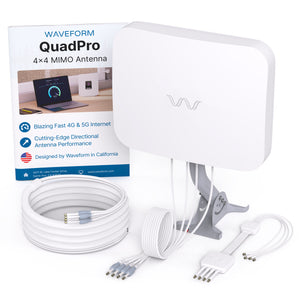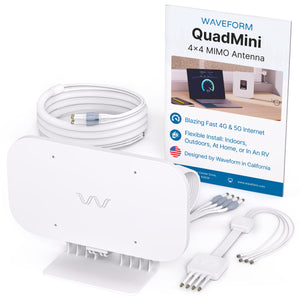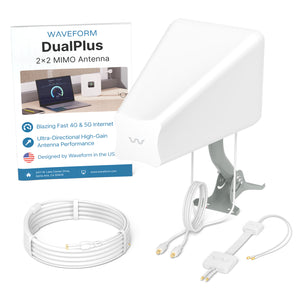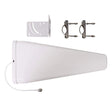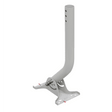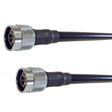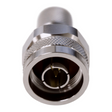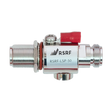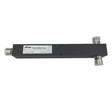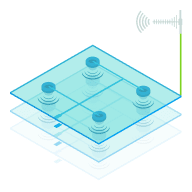Wyoming's wide-open geography and small population make public cellular networks inconsistent, especially once you leave Cheyenne, Casper, or Gillette. At the same time, outdoor WiFi struggles with harsh winters, 7,000-foot elevations, and relentless wind. Energy producers near the Powder River Basin, distribution centers along I-80, and university campuses in Laramie all share a common problem: they need low-latency data connections across hundreds of acres where fiber and DAS are impractical.
Industries And Sites That Benefit
-
Energy And Natural Resources
Coal mines in Campbell County, oil fields around Casper, and the state's growing wind-energy projects rely on rugged sensors, autonomous vehicles, and safety systems. A private network blankets a large lease with reliable, license-free CBRS spectrum, keeping data on-site and off the public internet.
-
Agriculture And Ranching
Large cattle operations and precision-ag fields demand connectivity for herd monitoring, soil probes, and drones. WiFi access points on fence posts simply cannot cover square miles of rangeland, whereas a handful of CBRS radios can.
-
Warehousing And Logistics
Along the Union Pacific corridor, warehouses in Rock Springs and Evanston use barcode scanners, AGVs, and yard-management tablets. Private 5G ensures instant handoffs as devices move indoors and out, with no carrier data fees.
-
Higher Education And Healthcare
The University of Wyoming and regional medical centers need secure, segmented networks for research data and IoT equipment. A private network lets IT keep traffic isolated from guest WiFi and commercial LTE.
-
Public Venues And Events
Rodeo arenas and seasonal festivals in Cody or Jackson can deploy a portable "network-in-a-box" to support ticketing, point-of-sale, and livestreaming without overloading public LTE carriers.
Wyoming building codes add another wrinkle: outdoor structures must withstand 115-mph wind loads, so antennas and masts need proper engineering. Our designs account for temperature swings from -40°F to 100°F, high-altitude UV exposure, and the lightning common on the high plains.
Why Private 5G Beats WiFi And Public LTE
Private 4G/5G operates in Citizens Broadband Radio Service (CBRS) spectrum at 3.5 GHz. As the spectrum holder, you control every SIM, device, and quality-of-service setting.
-
Compared With WiFi:
WiFi uses unlicensed 2.4 GHz and 5 GHz bands that are crowded and low-power. Outdoors, each access point covers only 150-300 feet. CBRS small cells legally transmit at far higher power and use advanced scheduling, so a single radio can reach thousands of feet with predictable throughput.
-
Compared With Commercial 5G:
Carriers bill per line, throttle heavy users, and backhaul traffic hundreds of miles to core networks. A private network keeps data local, cuts latency under 10 ms, and eliminates recurring carrier fees. You also choose when to upgrade hardware and software instead of waiting for carrier roadmaps.
For a deeper dive into spectrum, cores, and radios, visit our Private Networks Guide.
Our End-To-End Deployment Process
-
Rapid Site Snapshot
Email a site plan, a KMZ, or even a hand-drawn sketch. Within days we deliver an RF heat-map, capacity estimate, and budget range.
-
Detailed RF Design
Using professional propagation tools, we model terrain, building materials like tilt-up concrete or metal cladding, and Wyoming's wind-load requirements. The result is a bill of materials, coverage guarantee, and installation schedule.
-
Turnkey Installation
Our field team handles civil work, fiber pulls, power, and radio commissioning. We coordinate spectrum grants with the FCC's Spectrum Access Systems so you do not have to.
-
Device Integration
Need CBRS gateways for SCADA, intrinsically safe handhelds, or Zebra scanners? Because we are vendor-agnostic, we source, configure, and support the right hardware, then load your SIM profiles before shipment.
-
Ongoing Monitoring And SLA
You get a secure portal showing KPIs like throughput, latency, and user count. We patch and upgrade the core remotely and dispatch on-site support if needed.
Proof Of Execution In The Region
Although our specialties are private networks and DAS, our experience spans the Rocky Mountain region. One recent deployment was for Metropolitan Market, a high-end grocery chain documented in our Metropolitan Market case study. The project shows how we integrate wireless infrastructure in busy, RF-challenging environments and then layer in user devices. The same cross-disciplinary team that delivered that solution handles our Wyoming private-network installs.
Budgeting And Typical Costs
Indoor turnkey private networks usually fall between $1.00 and $2.50 per square foot, including small cells, edge core, SIMs, and first-year support. Outdoor coverage is even more economical. In the rolling terrain outside Gillette, for example, a three-sector tower can blanket roughly a 1.5-mile radius for about $100,000, assuming existing backhaul and power. Because every site is unique, we always price after we finish the rapid snapshot so you have data to justify ROI.
Operating costs are simple: a predictable annual support contract and zero carrier-line fees. Many Wyoming customers recoup the entire capital cost in under three years by eliminating public LTE subscriptions, replacing wired links, or boosting production uptime.
Get Started
Waveform delivers private networks without the headaches. From RF design to devices, we are your single point of accountability. Call us at (800) 637-4049 or get a custom private 5g design and quote today.























